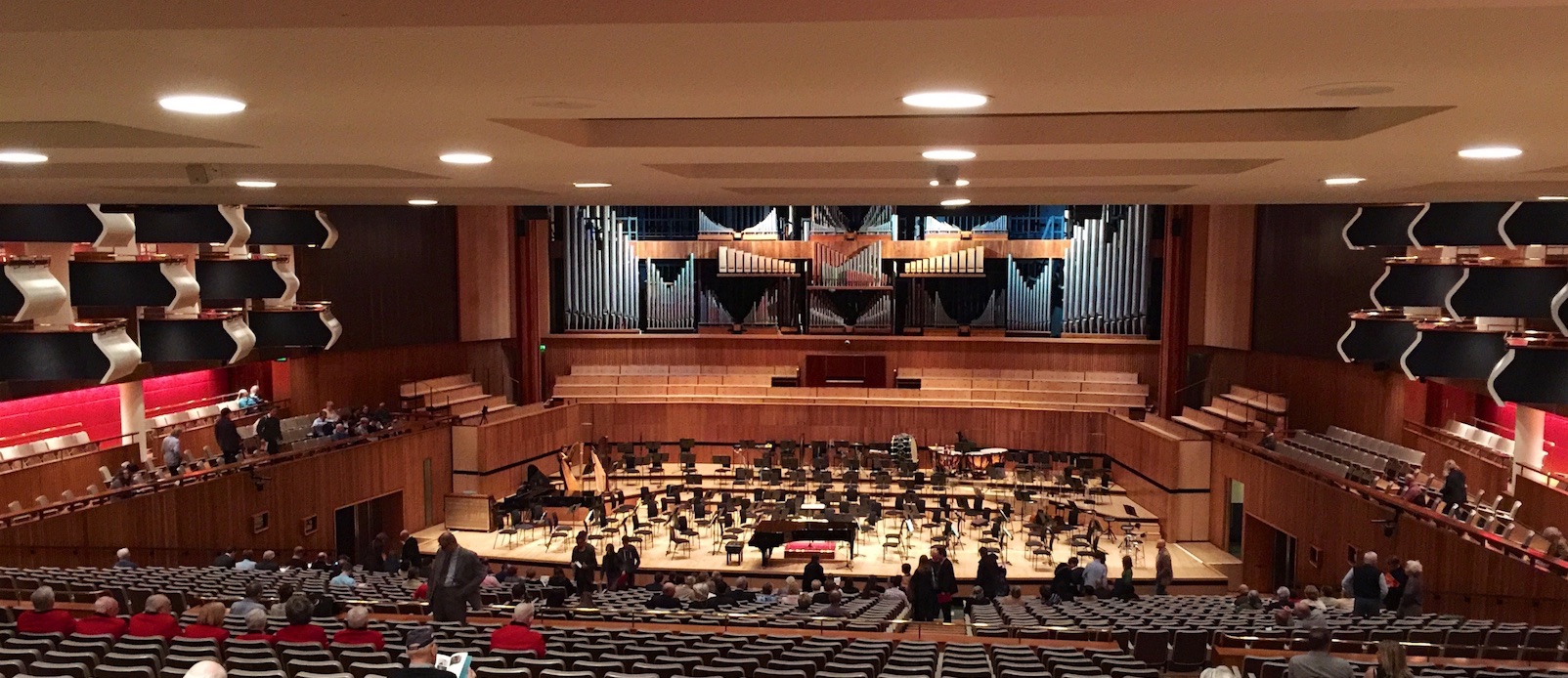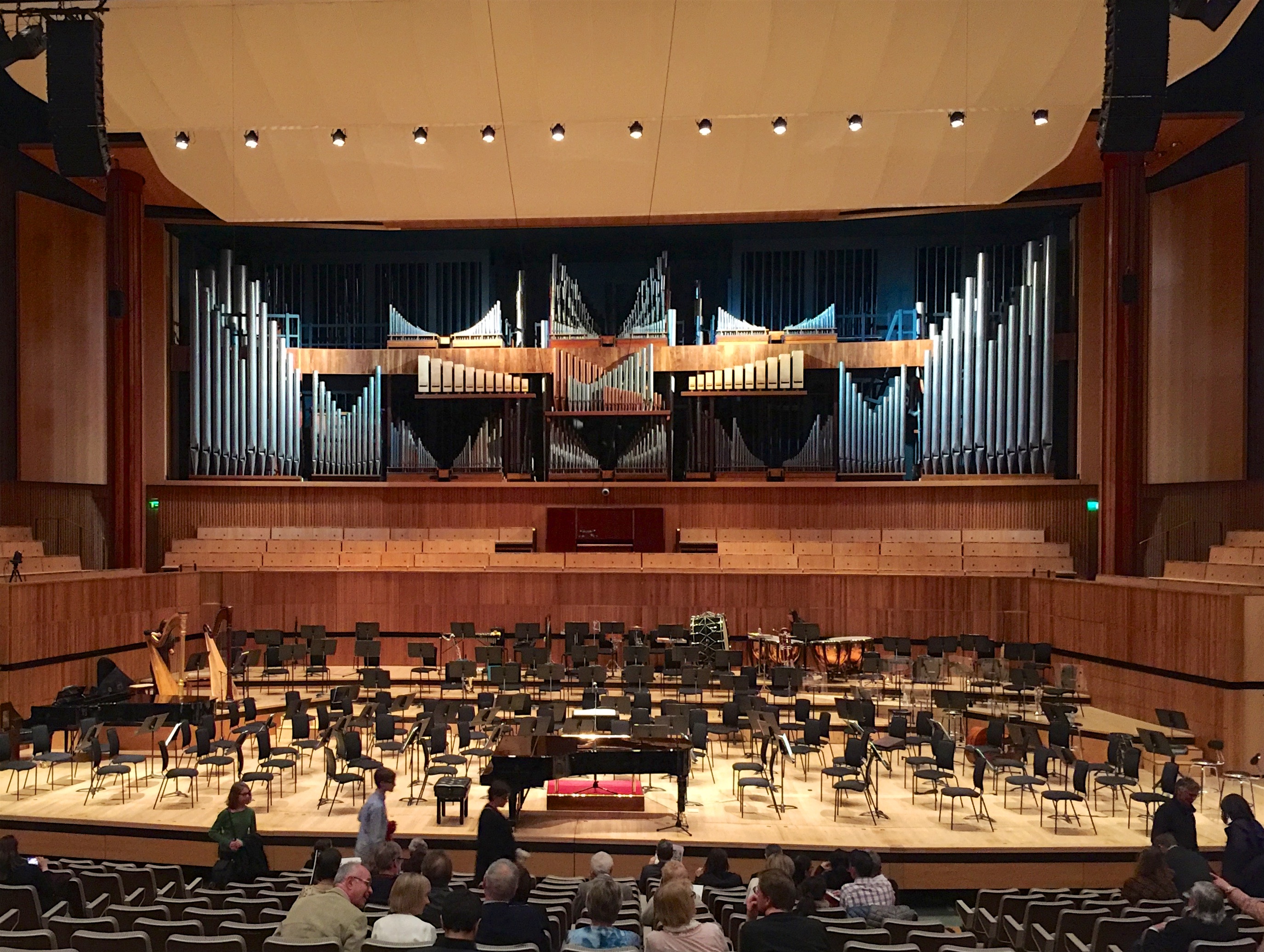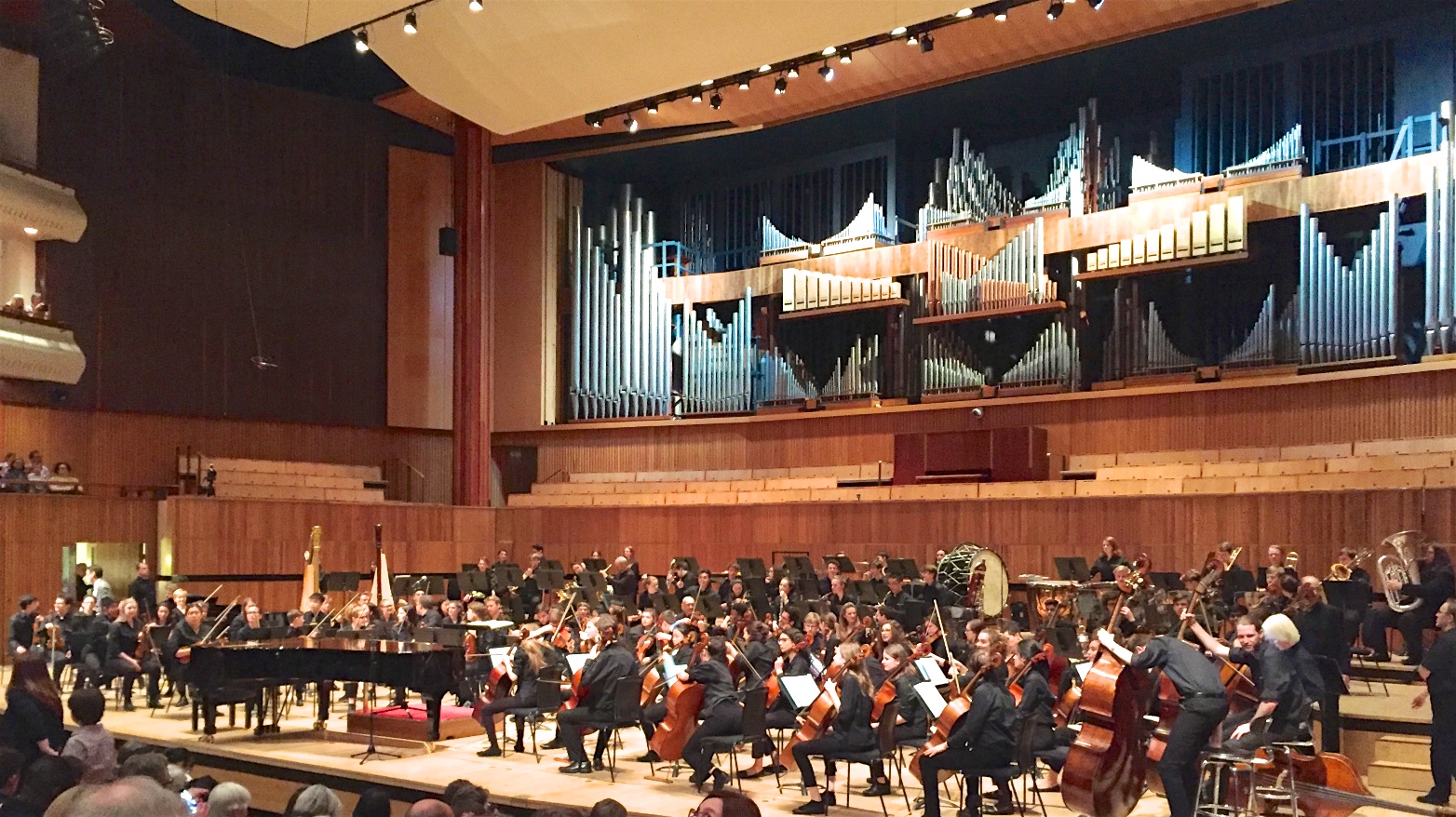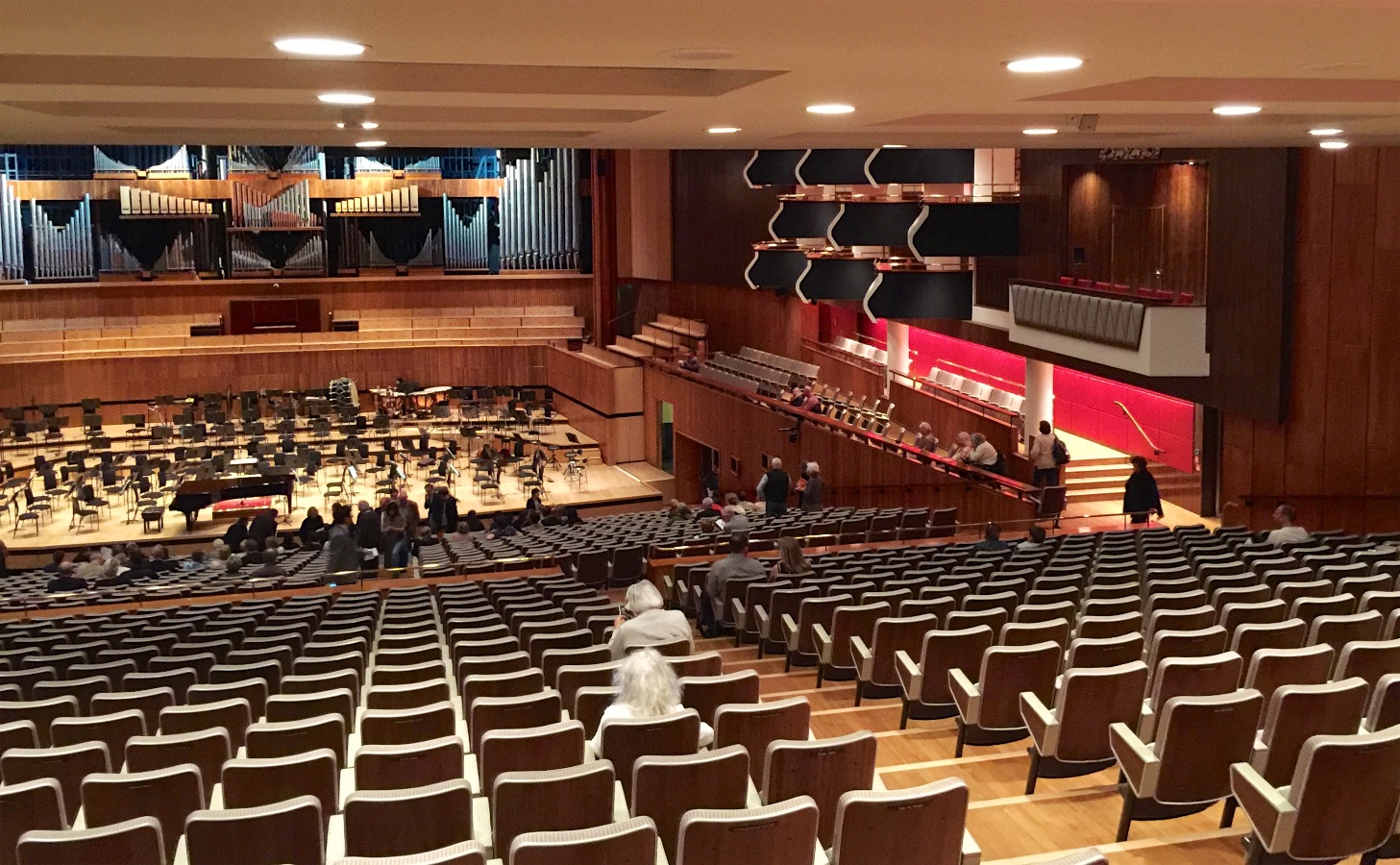Oxana Shevchenko, Ronald Corp / Duet Philharmonic Orchestra
Prokofiev / Mahler
London, Royal Festival Hall, 2017-04-10
2017-04-16 — Original posting
Table of Contents
Introduction
Setting, Venue, Orchestra
The Duet Group defines itself as a “specialist music services company”. Among other things, it offers the loan and the maintenance of music instruments for musicians, pupils at schools and universities. And every two years it unites young pupils into an orchestra, the Duet Philharmonic Orchestra, to perform major symphonic works in a big concert at Royal Festival Hall, one of the biggest venues in London’s Southbank Centre. This year, there were some 120 youngsters, most clearly below 20, from a selection of 26 schools around the U.K., all uniting into a big symphony orchestra. There were a few adults / teachers in the Duet Philharmonic Orchestra, supporting the young players.
The event was also received funding from the Mayor’s Music Fund, a charitable organization, initiated by Boris Johnson in his time as Mayor of the city of London, which since 2012 has helped almost 9000 underprivileged young musicians with grants of around £300,000 every year.
The declared goal of these biannual concerts is, to offer the young people a “lifetime experience”—an experience that they will draw from throughout their later life. This is almost guaranteed, given the difficulty of the repertoire that was selected. The concert featured pieces in which even professional orchestras and musicians are facing serious challenges.
Conductor
The Duet Philharmonic Orchestra was led by the experienced conductor, music educator, composer, and Church of England priest Ronald Corp, OBE (*1951). As a conductor, Ronald Corp founded and works with the New London Orchestra, as well as with the New London Children’s Choir. His main focus as conductor is in the music of the late 19th and the 20th centuries. See also the related entry on Wikipedia for additional information.
Soloist
The soloist of the evening was the Kazakh pianist Oxana Shevchenko (*1987). That’s an artist whom in my blog I don’t need to introduce, as I have written plenty of articles on her; for more see below.
Prokofiev: Suite No.2 from “Romeo & Juliet”, op.64ter — “Montagues and Capulets”
Sergei Prokofiev (1891 – 1953) composed his ballet “Romeo & Juliet” in 1935. It contains some of his most popular music. Given the success of the ballet, Prokofiev created three orchestral suites (No.1, op.64bis; No.2, op.64ter; No.3, op.101) from the ballet music. The first movement in the second suite is “Montagues and Capulets”, played here as opening piece for the concert. The central part of that movement is identical to No.13, “Dance of the Knights” (Scene 2) from the original ballet, while the beginning and the end correspond to No.6, “The Prince Gives His Order” (Scene 1).
With its “Dance of the Knights” theme, which is both well-known and popular, this movement made for an excellent opening piece. And it gave a first, mixed impression about the abilities and the limitations of the Duet Philharmonic Orchestra:
The Performance
The movement start with a challenge for the brass section: a dissonant chord that builds up in steps—very exposed, indeed! Here, that chord sounded more dissonant than intended by the composer. It seemed to take every voice a moment to find its “right place” in the dissonant cluster. Also further down in that piece, the wind section occasionally seemed to be fighting with the intonation, as well as with coordination. After the dissonant beginning, the strings set in with long pp notes. And they sounded very disciplined and homogeneous. But comparing that to the wind section is unfair, as the wind players are essentially all soloists, while there was a large number of string players, which makes it easier to create a homogeneous sound.
Things seemed to be easier as soon as the “Dance of the Knights” theme set in. Prokofiev’s catchy theme is easy to “understand”, seemed to motivate the young players. Some of the transitions were maybe slightly shaky. Not all of the punctuated rhythms were quite as concise as they should be. Overall, the instrumentalists offered a decent performance. I also noted that the brass section often dominated the sound. This could have been caused by the playing in the string sections was too restrained (in order to keep their sound homogeneity?). Or maybe the wind players succumbed to the temptation to expose the power of their instruments? Of course, with such a young orchestra, we are not looking for perfection, but the musicians should also be able to enjoy, maybe even have some fun!
Prokofiev: Piano Concerto No.2 in G minor, op.16
Sergei Prokofiev (1891 – 1953) wrote his Piano Concerto No.2 in G minor, op.16 in 1912/1913. I have written about this composition in an earlier posting, where I compared two recordings of this composition. So, here, I’m just listing the four movements:
- Andantino-Allegretto
- Scherzo: Vivace
- Intermezzo: Allegro moderato
- Finale: Allegro tempestoso
This is one of the most difficult works in the entire piano concerto literature.
The Performance
The primary victim of the exceedingly demanding program selection was Oxana Shevchenko. It’s not that the concerto was a challenge to her! Quite to the contrary: this is her declared favorite concerto (even though it is scarily difficult to play!). On the other hand, the composition was a challenge for the accompanying young musicians. The orchestral part in itself is tricky enough—but on top of that, the accompaniment must be coordinated with the solo part. And there are limits to how far a soloist can (and wants to) adjust to the accompaniment.
So, in order to keep the accompaniment under control, Ronald Corp chose a very careful tempo, almost throughout. In fact, especially in the first three movements, the tempo seemed so “careful” (i.e., slow) that the soloist appeared to have switched to a lower gear. She sometimes seemed to be running with brakes applied, unable to play out her pianistic strength and abilities. Thankfully, it did not entirely ruin her performance, though. She tried hard to make the best out of the situation.
I. Andantino — Allegretto
The movement starts all p, Andantino—and the Duet Philharmonic Orchestra only seemed to hint at the theme. In the third bar already, the solo takes over (with the tempo set by the orchestra). Oxana Shevchenko’s left hand calmly started the accompaniment, then the right hand began playing the main theme, all p initially, indeed narrante (telling stories), slowly building up to a first little climax. In the following solo, the moderate tempo may even have helped exposing the warm, expressive character of the music (caloroso con gran espressione), holding back, calm, slowly building up tension and drama.
In the Allegretto, though, the Duet Philharmonic Orchestra started so slow, rather clumsy, that Oxana Shevchenko cold not resist switching to a faster pace when the solo part started, even though this caused some disruption. I was happy about the switch, though, as the orchestra’s pace would have been anything but Allegretto! Luckily, the piano is largely dominating, controlling the rest of the movement. I found the soloist’s playing to be very differentiated in dynamics; she exposed the lyrical, mellow, singing aspects in the soft segments, while in the dramatic sections she focused on expression and exhibited plenty of power in her playing (rather than showing off virtuosity through speed).
Cadenza
The cadenza is extreme in its pianistic, technical demands (major parts are written in three rather than just two staves). Oxana Shevchenko started off very soft and gentle (Prokofiev annotates mp, dolce), then gradually—patiently, without rushing—built up volume, power and drama, up to the first, impressive, long climax (fff, precipitato), ending in a long chain of frighteningly tricky, wide-spanning and powerful arpeggiando waves. I found her playing to be very impressive: with all the power that she applied, exploring the full dynamics of the concert grand, she managed to highlight the melody line that hides in all the jaw-dropping, virtuosic maze that she deployed: excellent!
II. Scherzo: Vivace
The Scherzo (vivace) is only 2.5 minutes—yet, a single, relentless sequence of alternating / running semiquavers in the solo, with both hands in parallel. The piano part is intrinsically lacking contours, which makes it hard for the members of the orchestra to “attach” to the soloist. Ronald Corp gave his best in conducting with clear, precise gestures. However, despite the moderate pace, the Duet Philharmonic Orchestra took quite a while to coordinate, to adjust to the rhythm of the solo part. The soloist (faute de mieux) seemed to take the opportunity to exhibit emotionality rather than relentlessness and power in her part.
III. Intermezzo: Allegro moderato
The Intermezzo is annotated pesante (heavy)—it still is meant to be an Allegro moderato. The Duet Philharmonic Orchestra started this so slow and heavy, like an elephant’s dance, that Oxana Shevchenko felt compelled to correct the tempo—she succeeded only gradually and partially. I kept the impression that she wasn’t really challenged at all, even though also that movement is anything but easy. Oxana Shevchenko played with verve and vigor, yet, sometimes, her part (which technically left very little to wish for) sounded almost effortless, if not playful. On the bright side: even though it wasn’t quite what most would expect from this movement, I can’t deny some attractiveness in the light-hearted, pleasurable aspect of this (joint) interpretation!
IV. Finale: Allegro tempestoso
Only in the last movement, Allegro tempestoso, the soloist defines the tempo right from bar #1—and when she is let loose… Here, Oxana Shevchenko took and kept the lead position. She wasn’t ruthless, but clearly determined to bring out her view of the music, accelerating, where necessary (e.g., [103], [111]). To me, this ended up being the best movement of the evening: it was vivid, had “drive”, momentum in the dramatic parts, yet lyrical, cantabile and expressive, even sometimes sotto voce in the soft segments (e.g., [100]).
Very impressive: the cadenza in this movement, starting p, penseroso, going back even to pp, almost sotto voce, at the meno mosso. This is followed by a very impressive build-up to a powerful ff (sonoramente). That is technically very difficult, but still clearly exhibited the melody line in the right hand peak notes.
Conclusion
Only the last movement and the cadenza in the first movement gave a real idea about Oxana Shevchenko’s true pianistic, technical potential.
A few weeks ago, she has performed that same concerto in Cluj-Napoca / Romania, and I now could understand why one of the Romanian commentators named her a “new Argerich“. Such an attribute is definitely more than honorable, indicating an amazing achievement. However, I’m not sure whether it is even desirable (after all, I’d rather prefer a soloist to play his/her interpretation, rather than aiming at imitating somebody else’s!).
Mahler: Symphony No.5
Gustav Mahler (1860 – 1911) composed his Symphony No.5 in 1901 – 1903, it premiered in Cologne in 1904. I have written a detailed blog post with a comparison of several CD recordings, also containing a detailed description. Therefore, I’m just giving the outline of the structure. The symphony is in five movements, which Mahler groups into three parts. After the first part (at the end of movement 2), the composer explicitly notes “a long pause follows”:
- Part I:
- Trauermarsch (Funeral march): In gemessenem Schritt. Streng. Wie ein Kondukt (At a measured pace. Strict. Like a funeral procession.)
- Stürmisch bewegt, mit größter Vehemenz (Moving stormily, with the greatest vehemence) — [long pause]
- Part II:
- Scherzo: Kräftig, nicht zu schnell (vigorously, not too fast)
- Part III:
- Adagietto: Sehr langsam (Very slow)
- Rondo-Finale: Allegro – Allegro giocoso. Frisch (Fresh)
The Requirements
The technical (and musical) requirements for any orchestra (and the conductor, actually) are very high in this symphony. Therefore, one could expect that this work would reach or exceed the limitations of the Duet Philharmonic Orchestra with its young musicians. A work of the size and complexity of this symphony is challenging at numerous levels:
Technical Challenges on the Individual
- At the level of independent musicians: all wind instruments are soloists: here, limitations & errors will be obvious instantly (see movement 1 below). String players are less exposed, but their part is very long (the symphony is more than one hour!), often repetitive, tiring, see movement 2 below.
- String players in particular need to join into uniform teams / voices. It takes a lot of joint rehearsing, training, listening to each other, etc. to form a uniform “voice”; only few, professional orchestras reach the goal of a silky, recognizable, uniform string sound (see again movement 2 below).
- Throughout the orchestra, all musicians must watch out for perfect acoustic, dynamic balance—within their “local group or voice”, as well as within the orchestra as a whole. In parts, it’s the task of the conductor to control that balance, but this requires constant attention by all musicians.
Interpretations, Ensemble Performance
Above and beyond the “technicalities”, the abilities of the individual players to master their part, to coordinate, to form an ensemble, there is the art of interpretation, to explore the composer’s intent, to express it for the audience. That is not merely the work of the conductor, but also a question of how much the orchestra is able to follow and perform short-scale changes in tempo (agogics, rubato), to readjust instantly in transitions, to pick up on the conductor’s intent. That’s a part where even professional ensembles easily reach their limits—an area where one clearly could not expect a top performance, see movement 3 below.
The Performance
On a general note: Ronald Corp did his best in keeping his young musicians in line, through clear, concise and precise gestures, forming a resting pole in Mahler’s emotional turmoil. In many aspects, the performance worked out amazingly well. Sure (and understandably, from the remarks above), not everything was perfect. For example, there were instances if seemingly minor rhythmic imperfections that occasionally led to a slightly “fuzzy” soundscape.
Also, the acoustic balance in the Duet Philharmonic Orchestra often left room for improvement. As in the opening piece, the brass section (trombones, trumpets and tuba in particular) sometimes covered the other voices. The performance often was (too) brass-centered.
I. Trauermarsch: In gemessenem Schritt. Streng. Wie ein Kondukt
Some of the wind instrument players didn’t entirely master Mahler’s demanding orchestral score. Limitations could be heard both in intonation, as well as in rhythmic precision and coordination. In general, Mahler’s score is extremely demanding in terms of rhythmic precision ands conciseness. It was too demanding for this type of orchestra, I think. One prominent example are the frequent triplets in the funeral march (but these are challenging for just about any orchestra!).
However, there were some excellent wind soloists. One prominent example was the first trumpet, which sets the starting point to the symphony. The introductory solo featured triplets that were exactly as deliberately superficial as requested by the composer. Also later in the symphony, the trumpet player shone with excellent solos, even if those weren’t (could not be) as autonomous, not as independent as with professional orchestras.
Some of Mahler’s frequent transitions were maybe a bit problematic. But in general, the Duet Philharmonic Orchestra offered a fair performance.
II. Stürmisch bewegt, mit größter Vehemenz
In this movement is long, virtuosic, strenuous and demanding for the string players. They offered a fair performance here, though, expectedly, there is a fair way to go, for them to reach a uniform string sound / voice. Compared to professional orchestras, the strings lacked brilliance and uniformity, did not “lead the pack”, but were often dominated by the brass section. Besides balance, rhythmic contours and conciseness were another challenge here.
III. Scherzo: Kräftig, nicht zu schnell
This is another big, challenging movement: a challenge in intonation (throughout the Duet Philharmonic Orchestra), rhythmic precision and coordination. On top of all this, the “folk tone” in this music requires rhythmic freedom (as an ensemble, not individually, of course), some “swinging agogics”. That’s probably impossible to achieve with an ad hoc orchestra, let alone with such a young one.
Besides coordination in the polyphonic string sections with their virtuosic quaver theme, the major challenge here seems to be in the horn section. The problem was not in failing tones (the usually notorious “Hornkiekser“, as the Austrians call them): these rarely occurred here! The problem was in the intonation. The horns are cruelly exposed in this movement, and in the ff at [10], where Mahler explicitly asks for the horn bells to be raised up into the air (“Schalltrichter in die Höhe“, specified on every horn stave), the horn group suffered from severely diverging intonation. At the same time, the horn section included some excellent soloists!
IV. Adagietto: Sehr langsam
This was one of the better movements in this concert. The challenge here is not in virtuosity, rather in sonority, particularly the sound of the strings. Keeping a nice, singing tone while playing pp / ppp seemed harder than one would expect. The slow tempo also exposes problems in intonation in the strings—though these remained bearable, for sure. Sometimes, I wished for more expressive agogics, such as a small ritenuto prior to the climax in a phrase.
V. Rondo-Finale: Allegro – Allegro giocoso. Frisch
Here, the virtuosity is back, such as in the fugato in the strings, also for all wind instruments. The latter are very exposed already at the very beginning. Sure, there were coordination and intonation issues here and there, the occasional failing solo. However, overall, the performance was fair. I enjoyed some very good wind solos, such as tuba, trombones, the first horn, but also clarinet, oboe, flute. Despite all the limitation, I felt that in the end, Mahler still won over the instrumental imperfections. His music may lack catchy melodies / themes. Still, it is very direct in its expression, the emotions. And the end is enthralling, particularly where brass section (tuba, trombones, trumpets) dominates the scene.
Conclusion
Overall, I think that Mahler’s music shone through, reached the hearts of the listeners. The over 2000 people in the audience offered a warm applause—as they did after every single movement.
Still, I doubt that this symphony was a suitable choice of repertoire for this ensemble. Sure, one cannot possibly restrict performances with such orchestras to pieces such as Leopold Mozart’s Children Symphony (beware!). However, with an exceedingly ambitious repertoire selection such as Mahler’s Fifth, the danger of failure is evident and imminent. But even with its imperfections (or actually through its limitations), that symphony may have given the young musicians an indication of the length of the path to becoming a professional orchestra musician.
Throughout the program of the concert, the music as such must have impressed audience and performers. At the same time, I’m not sure how much the youth in the Duet Philharmonic Orchestra have experienced that concert as a “success story”. Realizing one’s own limitations can also be frustrating (I’m talking from experience!). therefore, a more adequate choice of repertoire might have given the young musicians a better experience—the feeling of having done it well, rather than (for some, maybe) “just about managed / made it through the piece”.
Measures, Ratings
In the end, I concurred with the editorial team from Bachtrack (for the German review at their site) not to rate this performance. A single measure cannot simultaneously and adequately reflect the performance of the Duet Philharmonic Orchestra, as well as that of the soloist, Oxana Shevchenko.
Ratings aside: my review may seem rather (too?) critical for such a young orchestra. One might consider applying “children’s measures” here, possibly dropping most of the critical remarks. However, this makes this inconsistent with other concert reviews, and it would not be helpful for the musicians in improving their performance for future concerts. Plus, I feel that I’m honoring the orchestra’s efforts by applying (more or less) standard measures, hence taking them seriously (professionally, so to say).
Overall, despite the limitations, the Duet Philharmonic Orchestra offered a very respectable performance: congrats for the achievement! I hope that this concert motivates the young musicians to continue, to re-double their efforts, to achieve even better results next time.
Addendum
For the same concert, I have also written a (shorter) review in German for Bachtrack.com; this posting is not a translation of the Bachtrack review, the rights of which remain with Bachtrack.com. I created the German review using a subset of the notes taken during this concert. I wanted to enable my non-German speaking readers to read about my concert experience as well. Therefore, I have taken my original notes as a loose basis for this separate posting. I’m including additional material that is not present in the Bachtrack review







